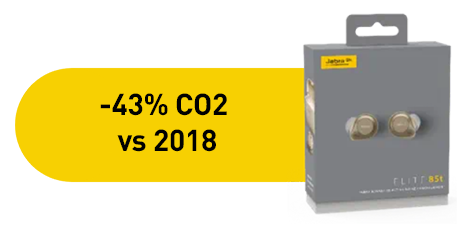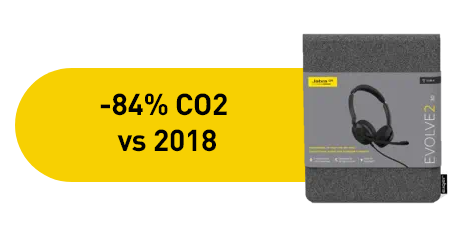
Tech of the future.
For the future.
Sustainability and decarbonisation.
At Jabra, sustainability is more than just a buzzword. It’s an important value embedded in our culture, operations, and product design. At the intersection of technology and sustainability, the circular economy empowers us to unlock new possibilities.
Jabra is focussed on sustainable design, decarbonisation and supply chain responsibility.

Sustainability across the full product lifecycle.
Jabra uses lifecycle assessments (LCAs) to analyse the environmental footprint of its products and make data-driven decisions on how to minimise its impacts.
How Jabra is working with sustainability at every stage, from pre-concepting to the end of the product’s life.
Jabra uses lifecycle assessments (LCAs) to analyse the environmental footprint of its products and make data-driven decisions on how to minimise its impacts.
How Jabra is working with sustainability at every stage, from pre-concepting to the end of the product’s life.
Materials.
Making Jabra’s products all starts with the materials. Using more sustainable materials means Jabra needs to consider recycled, bio-based and low-polluting alternatives for plastics, metals, fabrics and the raw ingredients of electronic parts and batteries. By 2025 Jabra intends to use over 50% of materials that meet its sustainability requirements in new products. The company is making progress towards this goal and launched its first products that contain recycled plastics in 2023.
Many Jabra products are TCO Certified, the only independent sustainability certification
for headsets covering the full lifecycle of products. For a full overview of TCO Certified Jabra products, see here
Packaging.
Jabra is on track to meet its 2025 target to have 100% FSC certified packaging ahead of time. In addition, it is aggressively phasing out virgin plastics in packaging and reducing the environment impact further through compact design. Through these efforts, the company has made carbon savings as high as 84% on its packaging lines since 2018.
Looking ahead, Jabra aims to drive its packaging footprint down further through scaling up local sourcing of packaging material and by working with suppliers on a more sustainable packaging setup across its supply chain.

2020
FSC box.
- FSC cardboard and paper
- Leatherette pouch
- Minimal virgin plastics
- No foam

2021
FSC paper pouch.
- FSC paper only
- PCR felt pouch
- No plastics

2022
FSC belly band.
- FSC paper only
- PCR felt pouch
- Smaller warranty leaflet
We use Youtube to embed video content on our website. This service may collect data on your activity. For more information, please go to the settings page.
Tech that works in harmony with nature.
Jabra is committed to reducing its
carbon emissions as fast as science tells us we have to.
This is how.
Ambitious emissions targets, rooted in science.
You only know how far you’ve come if you know where you started.
Jabra measures the carbon footprint across its business as well as on a product-level, and has set ambitious, science-based emission reduction targets. These GN Group-wide targets were approved by the Science Based Targets Initiative in 2022.
By 2030
In scopes 1 and 2 (areas under the company’s direct control) Jabra will reduce all carbon emissions by 80%. Scope 3 emissions (value chain emissions outside its direct operations) will reduce by 25% from a 2021 baseline.

By 2050
Jabra will achieve net-zero emissions by 2050 at the latest. In line with the criteria laid out by the Science Based Targets Initiative, this means reducing emissions by at least 90% and neutralising the rest through investing in carbon removal.


